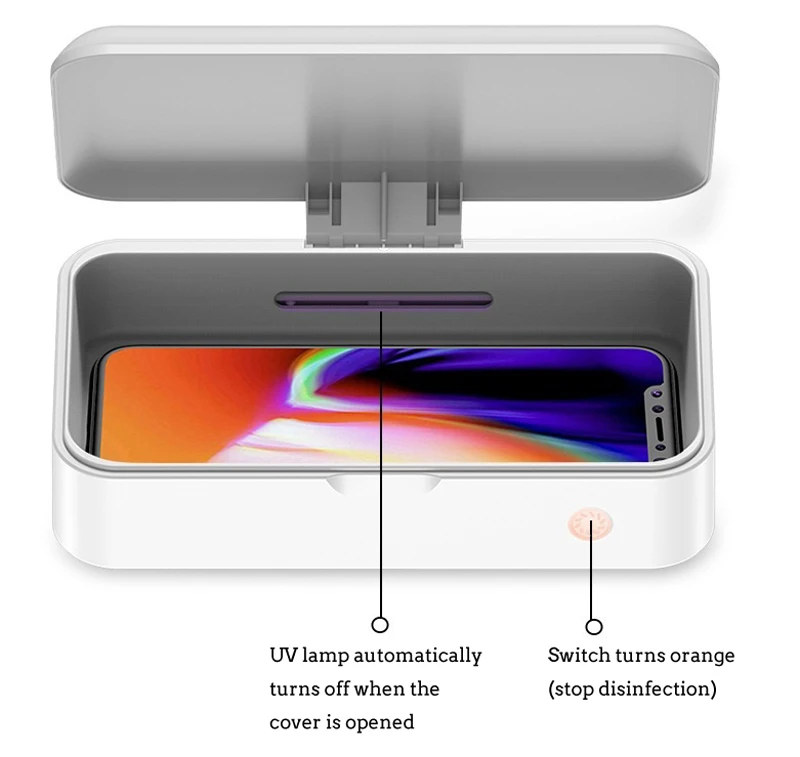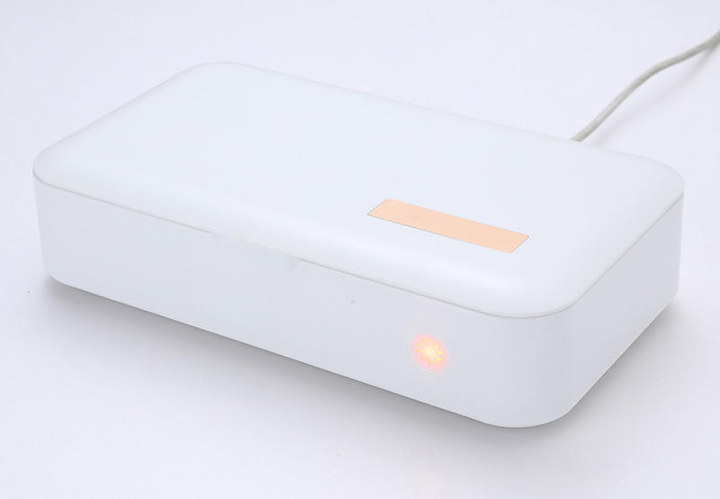This morning, as I browsed the web looking for products or other news, I found out that Banggood was selling a $23 UV sterilizer disinfection box that can clean & disinfect your smartphone, and other small items like surgical masks, using 3-minute of exposure to ultraviolet light.
I suppose it showed up in the new arrival feed because of the COVID-19 pandemic, and a relevant entry on Wikipedia states that UV light can kill bacteria and viruses since it destroys DNA and RMA. It works on humans too, and when I say work, it means humans should not subject themselves to strong UV light since it will damage their DNA too.
An article on Digital Trends mentions that while there aren’t many studies about the UV light effect on SARS-CoV-2, the virus causing COVID-19, it’s been shown to be effective against the similar SARS and MERS viruses, and hospitals are using robots zapping UV light to disinfect hospital rooms while face masks are being cleaned with UV treatment to allow reuse in this time of shortage.
Some basic specifications:
- Lights
-
Wavelength – 254nm
-
Lamps – 2x 2W
- Lamp life: 20000h
-
- Disinfection time – 3 minutes with LED indicator for status
- Input voltage: 5V 1A
- Dimensions
- External – 210 x 116 x H41mm
- Internal – 200 x 100 x 22mm
- Weight: 264g
- Material: ABS

For safety reasons, the box is hermetic in order to prevent UV light from leaking, and the UV lamp will turn off automatically when the lid is opened which may not be a bad idea since some people may decide to disinfect their hands that way, and it’s not safe, although I am not sure how much damage can be done with two 2W UV lights… [Update: Apparently a lot see comment]

Jean-Luc started CNX Software in 2010 as a part-time endeavor, before quitting his job as a software engineering manager, and starting to write daily news, and reviews full time later in 2011.
Support CNX Software! Donate via cryptocurrencies, become a Patron on Patreon, or purchase goods on Amazon or Aliexpress






UV-C is very dangerous: 2W is a *lot* and will quickly damage eyes and skin within tens of a second if not less. I have a 9W UV-C lamp and as far as I’ve understood it ought to kill germs 20cm away within 50ms or less.
Ozone blocks UV-C and that’s why the ozone layer matters that much. Keep in mind that merely with the currently slightly thinner ozone layer rougly above australia, the rate of skin cancer has vastly increased, includong among dolphins!
UV-C is terribly dangerous.
Thanks. When I think about UV lights, banknote checkers and mosquito traps come to mind, as well as UV light from the sun, so those are not very dangerous, but I’ve just learned there are different kinds of UV lights of varying danger.
UVC is absorbed by the atmosphere, not necessarily just ozone. Basically no UVC reaches the earth surface as a result. Skin cancer is caused by either UVA or UVB (still a hot topic in the literature as to which one is the culprit, or which is worse). UVC is more commonly found from artificial sources such as mercury lamps and welding arcs. Edit: just to be clear, skin cancer is not caused by UVC from the sun, purely because it can’t actually get to the surface of the earth, not because it isn’t dangerous. I’m not up to date on… Read more »
odd I read that some medical devices were made to use UV-C to avoid harm.. because it penetrate skin much less than other UV wlengths.
This will not irradiate the underside of your phone. Might even be worse than not using it if it makes people think that their phone is clean when it is not. If the light source is a mercury bulb then it’s likely to be 2W with best case 30% UVC output, so less than 600mW per bulb. Still very dangerous though. UV can also damage polymers with high dosages, and UVC is the highest energy type of UV. So it may damage plastic/cases on your phone or adhesive on the display. High intensity UV will also damage LCD displays (see… Read more »
I too thought about the non exposed side of the phone. The safest way with your phone is use it less and do not share. Also think about remote controls for tv, media players. Door knobs, handles, keyboards and mice. Light and plug switches also taps, cups.
Isopropanol at 75% should be more than enough for your phone. The only reason they don’t use this on masks is that it destroys the filter. Viricidal power of isopropyl or ethanol is not the problem with reusing masks.
Sadly how many self isolating people have that ready to hand?
Note i am in UK.
Basically any “wipes” you buy from the supermarket that aren’t “water only” have this or equivalent (granted they are being hoarded, but still). But yes, some countries do control technical alcohols quite tightly. 151 proof spirits is also equivalent to 75% ethanol, apparently that is quite easy to buy in the US (also apparently people drink that???)
Isopropanol is easy to buy here in Australia (or was until recently…). $30 AUD for 5L of 99% or so.
Technical alcohols and other solvents are readily available in the USA at any hardware store. Go to the paint section and you’ll find a nice selection. Your local pharmacy (chemist) will have 91% IPA. Any decent liquor store will have 197 proof EtOH–look for brands like Everclear. One note with the EtOH from the hardware store, it will have a denaturing agent in it. Most likely an agent that can leave an incredibly bitter aftertaste if used on surfaces which may reach the mouth. (https://en.wikipedia.org/wiki/Denatonium) Chemical supply stores are less common, but are readily patronized via mail order. Any solvent… Read more »
Is that what we in UK calls Meths.
” Methylated Spirits is commonly known as Meths, Denatured Alcohol or Ethanol (Ethyl Alcohol), it is a virgin alcohol mixed with a small quantity of Methanol to make it unfit for consumption, and dyed purple. “
Not exactly, while any additive that makes alcohol improper for human consumption is a denaturing agent, methylated spirits have methanol as a denaturing agent and are improper mostly due to the toxicity of methanol, while denatonium makes it improper by making it too bitter to drink, same objective different methods.
Just do note that if you get >75% alcohol, you do need to water it down to 75%. A bit counter intuitively higher concentrations are not as effective at disinfection.
https://en.wikipedia.org/wiki/Isopropyl_alcohol#Medical
Just received 2 bottles of Ethanol fuel for “Ethanol Fireplaces” from Amazon.de (I’m in Germany), as my previous 3 liter one is near the end after 3 years of use. It’s not for medicinal use, but as long as you don’t apply it to open wounds or drink it, should be perfectly fine to sanitize things like phones and door knobs.
stupid question, how do displays and platics react to UV-C ? since many materials are degraded by UV, you’d be happy to know what is the limit before destroying your phone
Unless these use a quartz enclosed gas discharge tube for the UV source, I highly doubt anything they claim. I’m not aware of any UV LED in that frequency range. I just purchased a replacement UV source for an air processing filter and it cost more than this whole system–and that’s without the HV source, etc. Producing UV and ozone for disenfection in reasonable quantities takes more than a couple of 395nm LEDs in a box.
Actually UV LEDs are available in wavelengths down to at least 255nm iirc, which is in the UV-C range and pretty close to one of the emission lines from low pressure Mercury vapour. You can even find some UV-c LEDs on digikey. There are also scientific papers on the use of uvc LEDs for pathogen inactivation: https://www.ncbi.nlm.nih.gov/pmc/articles/PMC6145099/ Edit: just to be clear I’m not saying this box works, I’m just saying that technology-wise it’s possible. It’s also perfectly possible that the box is not irradiating at low enough wavelengths or that it’s not powerful enough, thought longer irradiation times could… Read more »
Okay, let me clarify. I know that LEDs with emissions at pretty much any wavelength from deep UV to deep IR are available and have been for decades–IIRC, there was a place in Australia that made them–they are *horribly* inefficient. They’re good for lab uses if you need some specific known wavelength that you can’t get a laser for. But they’re so horribly inefficient that they’re not good for any kind of illumination. You can find simiconductors with the right band gap if you search hard enough, but getting high efficiency out of them is a different matter. The current… Read more »
Yeah I get it, hence the clarification about it possibly not being powerful enough. I got tired after going through about 10 references, none were 404 most were behind some paywall, and as for the article itself it is very much par for the course and I fail to see how it looks like a literature survey by a poor IA, especially given the very much reproducible description of their experiment (except for saying some things were carried at room temperature and leaving me to guess how hot their lab was when they carried the experiment). I suspect disinfecting your… Read more »
I suspect it is indeed using a tiny 254nm UV tube, they exist in various sizes. These heat a lot and will damage most plastics. I’ve used them to erase EPROMs and expose PCBs. They also slightly ionize air and produce ozone which causes this nice slightly bitter smell. Such wavelengths are really dangerous. During a summer 25 years ago we were infested by fleas due to cat and dog bringing them inside the house. After being really fed up with not being able to put a foot on the floor in my bedroom without it being covered with black… Read more »
Not just phones, how do average people even test these kill germs?
https://www.aliexpress.com/item/4000805875515.html?